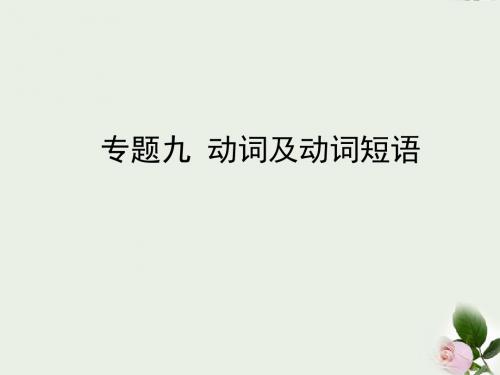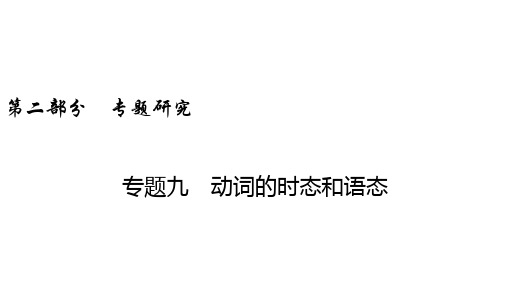中考英语语法复习课件:九动词的时态和语态
合集下载
中考英语总复习专题九动词及动词短语课件

⑥in短语 arrive in 到达
call in 拜访
believe in 信任;信赖 hand in 交上;提交;呈 送 join in 参加(=take part
或沮丧
write down 写下;记 下
in)
⑦off短语
keep off 避开;让开 clean…off 把……擦掉
⑧about短语 think about 考虑 care about 关心;在意 talk about 谈论;讨论;议论 worry about 担心;烦恼
take in 吸入;吞入(体内)
飞
take off 脱下(衣服等);起
take up 从事(工作、兴趣爱好等);着手处理
⑥turn短语 turn on 打开 turn off 关掉 turn out 结果是
turn up 调高(声音)
turn over 翻身;翻转 turn down 调低(声音) turn around 转身;调头
调查
⑬of短语 hear of 听说 think of 思考;考虑
⑭over短语
fall over 绊倒
⑮to短语 belong to 属于
listen to 听……
stick to 坚持;固守 talk to 跟……说 add…to 把……加到……上 lead to 导致;通向
lend…to… 借……给……
put down 记下;镇压
put into 把……放进;使进入 put on 穿上(戴上);上演;增加(体重) put up 张贴(广告等);搭建;举起
②look短语 look at 看 look for 寻找
look after 照顾
look through 浏览 look up 查找;查询 look around 向四周看
2020届中考英语 第9讲 动词的时态和语态课件 (共60张PPT)

【典题】
( )1.(2019 年淮安)—What is your mother doing, Linda?
—She ________ dinner in the kitchen now.
A.is cooking
B.was cooking
C.cook
D.cooking
答案:A
( )2.(2019 年上海)Look! They _______ about the solution
A talk C.was talking 答案:C
B.am talking D.talked
( )5.(2019 年镇江)—Oh! What's wrong with your finger?
—I hurt it while I ________ a model plane.
A.made C.am making 答案:B
live—lived
like—liked
move—moved (3)以一个辅音字母结尾的重读闭音节动词,双写该辅音字
母,再加-ed。如:
drop—dropped
stop—stopped
plan—planned
(4)以辅音字母加 y 结尾的动词,应变 y 为 i 再加-ed。如:
carry—carried cry—cried
3.动词第三人称单数变化方法与名词变复数相同。 (1)一般情况直接加-s。如:
stop—stops
look—looks
read—reads (2)以 s, x, ch, sh, o 结尾的动词加-es。如:
miss—misses watch—watches
fix—fixes wash—washes
专题09+动词的时态和语态【复习课件】-2023年中考英语二轮复习讲练测

• ★用法
用法
例句
Millions of people visit the Great 1. 表示现在经常性或习惯性的动
Wall every year.每年有数百万人参 作或存在的状态。
观长城。
Our teacher told us that light travels 2. 表示客观真理、科学事实及俗
come/go
be here/ there
finish die
be over be dead
marry join
be
be
married in
• 【易混辨析】(1)一般过去时和现在完成时
• 一般过去时:表示过去发生的动作或状态,与现在无关;现在 完成时:表示过去发生的某一动作对现在造成的影响或结果,强调 现在的情况。
一
般 构成:①will/shall+动词原形 ②am/is/are going to+动词原形
将 来
时间标志词:tomorrow, the day after tomorrow, next week/
时 month/year, in+一段时间(如:in two days), in the future等
much faster than sound.我们的老 语。
师告诉过我们光比声音传播得快。
用法
例句
3. 在when, as soon as, before等引 Turn off the lights before you leave
导的时间状语从句和if, unless等 home.出门前记得关灯。
2. 表示过去的习惯性动作或经常 when she was in the primary
2020年中考英语专题复习:动词的时态和语态(共30张PPT)

)2.(2018· 安 徽 , 44)The weatherman says a rain
shower ________ this afternoon in the south.
A.expects
C.is expected
B.expected
D.was expected
单项填空
( D )3.(2017·安徽,34★)I am surprised at the new look of my hometown, for it ________ a lot over the years. A.changed C.will change B.changes D.has changed
saves 节省) time. it ________(
单项填空
( B )1.(2018·安徽,35)Before the sun ________, we need to get to the top of the mountain. A.set C.is setting ( C B.sets D.will set
A.gives
C.will give
B.gave
D.has given
( B )5.(2016·安徽,34★)When the baby dog ______, it
was very hungry. So we gave it some food. A.is found C.has been found B.was found D.will be found
A.prepares
C.has prepared
B.is preparing
D.prepared
考点一 时态的分类及用法(必考)
中考英语动词时态讲解 PPT资料共46页.ppt

[解题技巧] 以此立意的试题考查考生能否通过“过去 动作对现在的影响”这一含义判断出动词 用现在完成时态。
本题中“从去年至今我都没有见过我的老 师了”,对现在的影响是“我想念老师”, 强调了“没有看”这一动作对现在的影响, 选C。
11. “经历”所采用的现在完成时态。
—Would you like to see the film with me?
4.现在进行时的用法
1) 现在进行时表示说话时或近阶段正在进 行的动作,由“be十现在分词”构 成.例如: Look! The students are reading. (说话 时正在进行的动作)
We’re all working for the 2019 Olympics.(近阶段正在进行的动作)
he _______.
A. returned C. will return
B. returns (成都)
[解题技巧] 以此立意的试题考查考生是否掌握了when, until, as soon as等引导的时间状语从句和if 引导的条件状语从句中的一般现在时态。
本题中的主句是一个一般将来时态,as soon as引导的从句用一般现在时态与之呼 应,选B。
My friend will come tomorrow. Mr Green will teach us English next term. 注:Will you do…? 还可表示一种请求的 语气。
如: I can’t carry the box, will you help me? 2) “ to be going to十动词原形”,表示即将
David had a good time yesterday. I usually got up early when I was young. 2)表示过去经常发生的动作,也可用 “used to+do”表示。例如: My father used to smoke. Grandma used to be a history teacher 注意;used to表示过去常发生而现在不 再发生的动作或存在的状态。
中考复习-动词时态 初中九年级英语教学PPT课件 人教版

A. came
B. is coming
C. was coming es
1.发生时间 2.时态结构
未来,还没发生的事
主语+will+动词原形+其他
将要做某事
主语+be(am/is/are) going to+动词原形+其他 打算做某事,根据现象进行推断
3.时态标志 1.tomorrow,next...,in the future,in +时间段
3.两个动作同时发生 长动作:过去进行时 短动作:一般过去时 when-- 长/短 while--长
两个长动作用while
1.当老师进门时我们在说话。 2.当我们在说话时老师进门了。 3.当我们在说话时,小明在写作业。
When the teacher came in ,we were talking.
2.There be 句型: There is/are oing to be There will be
打死不能改
3.主将从现
1.He has gone to Paris.He ______back in three days. A.will come es C. has come D.came
2. There ______ a heavy rain in Beijing tomorrow.
A. is
B. will be
C. is going to have D.will have
3.When he _____here,I________ you.
A. will come, will tell B. comes, tell
camping on the Fenghuang mountain.
中考英语语法专项复习——动词时态PPT优秀课件

C. have been to;have come D. has been;come
9. —I have finished my homework.
—When ___ you ___ it ?
A. have; finished B. do; finish C. did; finish D. will;
gets up 3. Listen! Xiao Li ___ an English song. A. is singing B. sings C. is going to sing D. sang 4. The harder you ___, the better results you will get. A. will study B. studied C. study D. studying 5. The teacher told us in class that the earth ___
14. The whole class
to the East Lake if it is fine
this Sunday.
A. will go B. have gone C. go
15. Who
? It sounds like a little girl.
A. does cry B. is crying C. cried
过延到现 I have been in this school
since 1999 .
He has been to China twice.
两“去” He isn’t here. He has gone to
the library.
中考英语语法专项复习——动词时态P PT优秀 课件
中考英语语法专项复习——动词时态P PT优秀 课件
初三中考二轮复习语法专题动词时态专项PPT精品课件

2. 祈使句+and/or+含有将来时的句子。如:Work hard, and you will succeed. 努力工作,你将会成功。
初三中考二轮复习语法专题动词时态 专项课 件(共48 张PPT)
初三中考二轮复习语法专题动词时态 专项课 件(共48 张PPT)
4
现在进行时
初三中考二轮复习语法专题动词时态 专项课 件(共48 张PPT)
初三中考二轮复习语法专题动词时态 专项课 件(共48 张PPT)
五、过去进行时 结构:主语+was/were+v.ing形式 用法:1. 表示过去某个时刻正在进行的动作。 句中常常包含 at that time, at this time yesterday, at 7:00
last night, at that moment 等时间状语,有的则是通过上下文语 境暗示某动作在过去的某个时刻正在进行。如:
初三中考二轮复习语法专题动词时态 专项课 件(共48 张PPT)
初三中考二轮复习语法专题动词时态 专项课 件(共48 张PPT)
2. 表示在过去一段时间内,经常性或习惯性的动作。 常与always, usually, often, sometimes, never 等频度副词连用。
如:He missed his parents so much and he often felt lonely and unhappy.他非常想念他的父母,他经常感到孤独和不快乐。
初三中考二轮复习语法专题动词时态 专项课 件(共48 张PPT)
初三中考二轮复习语法专题动词时态 专项课 件(共48 张PPT)
3
一般将来时
ห้องสมุดไป่ตู้
初三中考二轮复习语法专题动词时态 专项课 件(共48 张PPT)
初三中考二轮复习语法专题动词时态 专项课 件(共48 张PPT)
初三中考二轮复习语法专题动词时态 专项课 件(共48 张PPT)
4
现在进行时
初三中考二轮复习语法专题动词时态 专项课 件(共48 张PPT)
初三中考二轮复习语法专题动词时态 专项课 件(共48 张PPT)
五、过去进行时 结构:主语+was/were+v.ing形式 用法:1. 表示过去某个时刻正在进行的动作。 句中常常包含 at that time, at this time yesterday, at 7:00
last night, at that moment 等时间状语,有的则是通过上下文语 境暗示某动作在过去的某个时刻正在进行。如:
初三中考二轮复习语法专题动词时态 专项课 件(共48 张PPT)
初三中考二轮复习语法专题动词时态 专项课 件(共48 张PPT)
2. 表示在过去一段时间内,经常性或习惯性的动作。 常与always, usually, often, sometimes, never 等频度副词连用。
如:He missed his parents so much and he often felt lonely and unhappy.他非常想念他的父母,他经常感到孤独和不快乐。
初三中考二轮复习语法专题动词时态 专项课 件(共48 张PPT)
初三中考二轮复习语法专题动词时态 专项课 件(共48 张PPT)
3
一般将来时
ห้องสมุดไป่ตู้
初三中考二轮复习语法专题动词时态 专项课 件(共48 张PPT)
九年级英语专题复习:动词的语态课件

例如:He 例如:He is planting trees in the park. →Trees are being planted (by him) in the park. be + v-ed 思考1 思考1:18. She gave me a book. was _____ →I ____ given a book (by her). was _____ to →A book _____ given _____ me (by her). 19. My mother bought me a MP4 last year. →I ____ boughta MP4 (by mother) last year. was ____ →A MP4 ____ bought____ me (by mother) last year. was ____ for 小结1 小结1:谓语动词带双宾语时,既可以将间接宾语转化成主语, 也可以将直接宾语转化成主语。若将间接宾语转化成主语,则保 留直接宾语;若将直接宾语转化成主语,则保留间接宾语,且在 被保留的间接宾语前加上介词to或for。 被保留的间接宾语前加上介词to或for。 思考2 思考2:20. We asked him to sing an English song. →He was asked to sing an English song (by us). ____ ____
四、主动语态和被动语态的转换 先看例句:We 先看例句:We often clean the classroom after school. 这是一个谓语动词为主动语态的句子,动词(即谓语)为:clean, 这是一个谓语动词为主动语态的句子,动词(即谓语)为:clean, 动作的执行者(即主语)为:we, 动作的对象(即宾语)为:the 动作的执行者(即主语)为:we, 动作的对象(即宾语)为:the classroom。若将其变为被动语态的形式可按下列三个步骤进行: classroom。若将其变为被动语态的形式可按下列三个步骤进行: 1.将动作的对象(即宾语)作为被动句的主语; 1.将动作的对象(即宾语)作为被动句的主语; 2.将谓语动词变为被动语态形式; 2.将谓语动词变为被动语态形式; 3.将动作的执行者(即主语)变为被动句中介词by的宾语。 3.将动作的执行者(即主语)变为被动句中介词by的宾语。 We often clean the classroom after school. The classroom is often cleaned (by us) after school. 其中的难点为动词被动语态形式的确定,我们不妨也把它分为两 步完成: 1.先确定动词的过去分词形式(它是一个常量); 1.先确定动词的过去分词形式(它是一个常量); 2.再确定be(它是一个自变量)。be采取什么形式,根据两个原 2.再确定be(它是一个自变量)。be采取什么形式,根据两个原 则:(1)原主动句的时态;(2 则:(1)原主动句的时态;(2)现被动句主语的人称及单复 数。
深圳中考英语复习课件 动词的时态和语态(共48张PPT)

即学即练
用括号里所给单词的适当形式填空或按要求完成句子。 didn’t go (not go) to bed until 11:00 o’clock last 1. Jenny _________ night. go (go) out just now. 2. I _____ saw (see) Li Lei ______ 3. They ________ bought (bought) a guitar yesterday. cleaned (clean) the classroom yesterday. 4. Tom _________ used (use) to do exercise in the gym. 5. I _______
3. — ______ Is he ________ doing (do) his homework now? Yes, he is — ___________. (肯定回答)
考点四:一般将来时的典型用法
1. “祈使句 + and / or + 句子”结构中后面的句 子中的谓语可用一般将来时。 如:Hurry up,or you will miss the bus.
动词的时态
标志 特殊用法
表示将来的时间的 相关词汇: tomorrow, next week, in the future, soon,how soon, in 10 days, in 2020
/
第一节
动词的时态
时态及 特殊用法 标志 其主要用法 过去将来时 1.表示从过去某个时间 常用于主句是一般过 去时的宾语从句中。 看将要发生的动作或存 如: 在的状态,即“从过去 I told him I would 看将来” / finish that project the 2.句子结构: next day. (1)主语+would+动词原 形 我告诉他我会在第二 (2)主语+was / were 天完成那个项目。 going to+动词原形
用括号里所给单词的适当形式填空或按要求完成句子。 didn’t go (not go) to bed until 11:00 o’clock last 1. Jenny _________ night. go (go) out just now. 2. I _____ saw (see) Li Lei ______ 3. They ________ bought (bought) a guitar yesterday. cleaned (clean) the classroom yesterday. 4. Tom _________ used (use) to do exercise in the gym. 5. I _______
3. — ______ Is he ________ doing (do) his homework now? Yes, he is — ___________. (肯定回答)
考点四:一般将来时的典型用法
1. “祈使句 + and / or + 句子”结构中后面的句 子中的谓语可用一般将来时。 如:Hurry up,or you will miss the bus.
动词的时态
标志 特殊用法
表示将来的时间的 相关词汇: tomorrow, next week, in the future, soon,how soon, in 10 days, in 2020
/
第一节
动词的时态
时态及 特殊用法 标志 其主要用法 过去将来时 1.表示从过去某个时间 常用于主句是一般过 去时的宾语从句中。 看将要发生的动作或存 如: 在的状态,即“从过去 I told him I would 看将来” / finish that project the 2.句子结构: next day. (1)主语+would+动词原 形 我告诉他我会在第二 (2)主语+was / were 天完成那个项目。 going to+动词原形
专题09-动词的时态和语态-备战中考英语专项突破课件(语法篇)

—Do you have a baseball?
七上 Unit
—Yes,I do./No,I don't.(教材第 27 页) —Does she have a tennis ball?
5
—Yes,she does./No,she do的时 现在
态和
时 语态
七上 Unit 6
—Do you like salad? —Yes,I do./No,I don't.(教材第 33 页) —Does she like tomatoes? —Yes,she does./No,she doesn't.(教材 第 33 页)
七下 Unit —What are you doing?
动词 现在
6
—I'm watching TV.(教材第 33 页)
的时
进行
—What are they doing?
态和 语态
时
七下 Unit —They're playing basketball
7
thepark.(教材第 39 页)
in
动词 的时 态和 语态
一般 过去 时
—How was your school trip?
He missed his parents so much
表示过去某一段时 and he often felt lonely and
间内经常或反复发 unhappy.他很想念他的父母,并
生的动作
且他经常感到孤独和难过。【九全
Unit 4 第 30 页】
学习一般现在时,基本用法要熟悉; 表示动作常发生,特征、性格和能力; 存在状态和习惯,客观事实与真理; 如果主语是单三,谓语就要变一变。
中考英语课件 专题9 动词的时态和语态

watched 现在完成时;was watching 过去进行时;will watch 一般
将来时。根据上句句意:你看起来很累!可知答句句意是:我丈
夫整晚都在看足球比赛。那太吵了!表示“昨夜一直在干某事”,
时态应用过去进行时,其结构是was/were+v.-ing。故选C。
• 【答案】 C
考点二 常见的被动语态
一般 +动词原形 will表示客观上将来势必发生的事情。主语可以是人也
将来 2.be going 可以是物。
时 to + 动 词 原 3.在含有时间、条件状语从句的复合句中,主句是一
形
般将来时,从句用一般现在时来代替将来时。
4.一些表示位移的动词,如go,come,leave,arrive,
fly,start,move等,常用现在进行时表将来。
• C.succeeded D.have succeeded • 【解析】 考查一般将来时态。句意:不要气馁,如果你继 续努力工作,总有一天你会成功的。本句为if引导的条件状语从 句复合句,遵循“主将从现”的规则。再从some day可知,本主 句应用一般将来时态表达。故选A。
• 【答案】 A
• 2.(2022·镇江)—You look tired!
The went
young man was away from school.
把指人的宾语变为主语时,指物的
含 双 宾 语 的 宾语仍保留在谓语之后;指物的宾 I was given a present.
动词
语变为主语时,指人的宾语前要加 A present was given to
相应的介词。
me.
第二部分 专题研究
专题九 动词的时态和语态
- 1、下载文档前请自行甄别文档内容的完整性,平台不提供额外的编辑、内容补充、找答案等附加服务。
- 2、"仅部分预览"的文档,不可在线预览部分如存在完整性等问题,可反馈申请退款(可完整预览的文档不适用该条件!)。
- 3、如文档侵犯您的权益,请联系客服反馈,我们会尽快为您处理(人工客服工作时间:9:00-18:30)。
时态及构成
用法
示例
表示过去发生的动作对现在造成 I have seen the film
的影响或结果,常与 already,yet already.我已经看过这
现在完成时
等词连用
部电影了。
(have/has+
表示动作从过去开始一直持续到 So far,they've only 动词的过去
现在,并有可能继续下去,常与“for finished half of the
wake up→be awake fall asleep→be asleep join→be in leave→be away 如:(误)I've left this school for ten years. (正)I've been away from this school for ten years.
( D )7.(2019·温州)—Linda,Dad has finished his work and we
to
the gym to pick you up. —Thank you,Mum.
A.drive
B.drove
C.have driven
D.are driving
( A )8.(2019·淮安)—What is your mother doing,Linda?
动词一般过去时,过去时间做标记; 表示过去发生事,谓语要用过去式; 否定句很简单,主语之后 didn't 添; 疑问构成也简单,主语前面 did 添; 还有一点不能忘,后面谓语现原形。
( C )1.(2019·临沂)—I'm getting hungry.Do you know where we can get
英语 第二部分 语法专项突破篇
(九)动词的时态和语态
中考考点透视
考点一:动词的时态
◆一般现在时和一般过去时
时态ቤተ መጻሕፍቲ ባይዱ构成
用法
示例
一般现在时(主 表示经常性或习惯性的动
语+动词原形/动 作或状态,常与 often,
The boy always gets to school early.这个男
词的第三人称单 usually,always,sometimes, 孩总是很早到校。
( A )14.(2019·武汉)I ate some fruit,which I
since I was a child,
and the vegetables from my garden. A.have enjoyed
B.enjoyed
C.enjoy
D.had enjoyed
( B )15.(2019·宜 昌 )—What great progress Huawei
◆一般将来时
时态及构成
用法
示例
表示将来要发生的动作或存
一般将来时
在的状态,常与 tomorrow,
My friend will go to America in two days.两天后我的朋友将去美
(will/shall+ next time,in +时间段,in the 国。
future 等时间状语连用
years!
—No wonder it is widely known in all parts of the world.
A.is making
B.has made
C.makes
D.made
in recent
( D )16.(2019·安徽)—It's ten years since we came here.
some good food?
—Of course! There
a restaurant around the corner.
A.will be
B.was
C.is
( A )2.(2019·武汉)She's brought you some eggs.As you know,she
chickens. A.keeps
B.am reading
C.was reading
D.have read
( B )10.(2019·滨州)—I called you last night,but nobody answered.
Where were you then?
—Oh,I
my pet dog in my yard.
A.walked
—She
dinner in the kitchen now.
A.is cooking
B.was cooking
C.cook
D.cooking
( B )9.(2019·江西)—Hurry up!
—One moment.I
my e-mail and then I'm ready to go.
A.read
B.will keep
C.has kept
D.kept
( A )3.(2019·北京)Sam A.skates C.has skated
with his friends every weekend. B.is skating D.was skating
( B )4.(2019·黄石)In February,Chinese tech company Huawei
—How time flies!We
in China for so long.
A.work
B.worked
C.will work
D.have worked
( A )17.(2019·黄冈)—Where is Catherine?I haven't seen her for days.
—She
Wuhan.She'll be back next week.
分词)
+时间段”或“since+表示过去的 task.到目前为止,他们
时间点或句子”连用
只完成了一半的任务。
英语现在完成时,谓语结构要牢记; “have/has+过去分词”,主要用法有两个; 动作发生在过去,结果影响到现在; 常用 just,already,过去的动作或状态; 一直延续到现在,for 和 since 把时间带。
B.had met D.would meet
( A )6.(2019·南京)—Wendy,how long have you had the Huawei P30
Pro?
—A couple of days.I A.bought
it last week. B.buy
C.will buy
D.have bought
与 always,usually 等词 He is always thinking about
连用,表示赞扬、厌恶或 himself.他总是为自己考虑。
不满的情绪
时态及构成
用法
示例
表示过去某个时刻或 I was watching TV at eight
某段时间内正在进行 o'clock last night.昨天晚
A.are spoken
B.spoke
C.have spoken
D.are speaking
( B )13.(2018·重庆 B 卷)Listen!Mr.Black
a talk on robots in the
hall. A.gives
B.is giving
C.will give
D.gave
◆现在完成时
B.was walking
C.am walking
D.will walk
( A )11.(2019·河南)—Jim,could you please answer the question?
—Sorry,I .Could you say it again?
A.wasn't listening
B.don't listen
◆现在进行时和过去进行时
时态及构成
用法
示例
现在进行时 (am/is/are+ 动词的现在 分词)
表示说话时或目前正在 The students are doing their
进行的动作,也可以表示 homework in the classroom.学
现阶段或一段时间内正 生们正在教室里做作业。
在发生的事
数形式)
般现在时表将来
明天不下雨,我将离开。
时态及构成
用法
示例
表示过去发生的动作或存在
一般过去时
的状态,常与 yesterday,a few days ago,just now,in
They saw the new movie last night.昨天晚上他们 看了这部新电影。
(主语+动词 1980 等时间状语连用
C.am not listening
D.won't listen
( D )12.(2018·黄 石 )More and more foreign students begin to learn
Chinese,and many of them
Chinese better and better now.
2.现在完成时中表示短暂动作的动词不能与 for,since 等引导的时间 状语连用。若要与一段时间连用,则要将瞬间动词转化为意思相近的延续 性动词。常见的变化如下:
buy→have borrow→keep open→be open close→be closed begin/start→be on come→be here go→be there finish→be over die→be dead catch a cold→have a cold put on→wear
